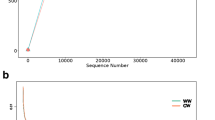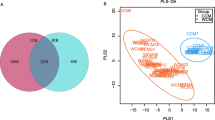Abstract
Gastrointestinal microbiome plays an important role in animal metabolism, immune system and pathology associated with health and disease. Many wild slow lorises were confiscated from illegal trade into captivities and experienced a range of changes in living environment and diet. Microbiome analysis contributes to improving captive management by identifying the alteration in their gastrointestinal microbial communities and aiding in determining the factors affecting the health of captive slow lorises. The fecal samples of eighteen Bengal slow lorises (Nycticebus bengalensis) were used to compare gut microbiota from four rescue centers located in Dehong, Gejiu, Nanning and Puer cities of China. The results showed a significant site-dependent difference in microbial community diversity. Similar to other Lorisinae species, the Phyla including Bacteroidetes, Firmicutes and Proteobacteria dominated their gut microbiome composition. The Gejiu group exhibited a higher overall diversity and the unique OTUs, which is resulted from long-term isolated husbandry and heavy human disturbances. The scarcity of gums in the captive diet was likely to cause a lower abundance of Prevotella associated with soluble fiber degradation. The variation of intestinal microbiota in different environments highlights the necessity to improve feed preparation and husbandry management for the captive Bengal slow lorises.





Similar content being viewed by others
Data Availability
The data that support the findings of this study are openly available in National Center for Biotechnology Information (NCBI) at https://www.ncbi.nlm.nih.gov/sra/PRJNA579291, reference number PRJNA579291.
References
Walsh PD, Abernethy KA, Bermejo M, Beyers R, De Wachter P, Akou ME, Huijbregts B, Mambounga DI, Toham AK, Kilbourn AM (2003) Catastrophic ape decline in western equatorial Africa. Nature 422:611–614
Estrada A, Garber PA, Rylands AB et al (2017) Impending extinction crisis of the world's primates: why primates matter. Sci Adv 3(1):e1600946
Stumpf RM, Gomez A, Amato KR, Yeoman CJ, Polk JD, Wilson BA, Nelson KE, White BA, Leigh SR (2016) Microbiomes, metagenomics, and primate conservation: new strategies, tools, and applications. Biol Conserv 199:56–66
Barelli C, Albanese D, Donati C, Pindo M, Dallago C, Rovero F, Cavalieri D, Michael Tuohy K, Christine Hauffe H, De Filippo C (2015) Habitat fragmentation is associated to gut microbiota diversity of an endangered primate: implications for conservation. Sci Rep 5:14862
Yatsunenko T, Rey FE, Manary MJ et al (2012) Human gut microbiome viewed across age and geography. Nature 486(7402):222–227
Gomez A, Rothman JM, Petrzelkova K, Yeoman CJ, Vlckova K, Umaña JD, Carr M, Modry D, Todd A, Torralba M (2016) Temporal variation selects for diet-microbe co-metabolic traits in the gut of gorilla spp. ISME J 10(2):514–526
McCord AI, Chapman CA, Weny G, Tumukunde A, Hyeroba D, Klotz K, Koblings AS, Mbora DNM, Cregger M, White BA (2014) Fecal microbiomes of non-human primates in Western Uganda reveal species-specific communities largely resistant to habitat perturbation. Am J Primatol 76(4):347–354
Amato KR, Leigh SR, Kent A, Mackie RI, Yeoman CJ, Stumpf RM, Wilson BA, Nelson KE, White BA, Garber PA (2015) The gut microbiota appears to compensate for seasonal diet variation in the wild black howler monkey (Alouatta pigra). Microb Ecol 69(2):434–443
Bennett G, Malone M, Sauther ML, Cuozzo FP, White B, Nelson KE, Stumpf RM, Knight R, Leigh SR, Amato KR (2016) Host age, social group, and habitat type influence the gut microbiota of wild ring-tailed lemurs (Lemur catta). Am J Primatol 78(8):883–892
Amato KR, Yeoman CJ, Kent A, Righini N, Carbonero F, Estrada A, Rex Gaskins H, Stumpf RM, Yildirim S, Torralba M (2013) Habitat degradation impacts black howler monkey (Alouatta pigra) gastrointestinal microbiomes. ISME J 7:1344–1353
Clayton JB, Vangay P, Huang H, Ward T, Knights D (2016) Captivity humanizes the primate microbiome. P Natl Acad Sci USA 113(37):10376–10381
Kohl KD, Amaya J, Passement CA, Dearing MD, McCue MD (2014) Unique and shared responses of the gut microbiota to prolonged fasting: a comparative study across five classes of vertebrate hosts. FEMS Microbiol Ecol 90(3):883–894
Nakamura N, Amato KR, Garber P, Estrada A, Mackie RI, Gaskins HR (2011) Analysis of the hydrogenotrophic microbiota of wild and captive black howler monkeys (Alouatta pigra) in palenque national park. Mexico Am J Primatol 73(9):909–919
Cornick NA, Jensen NS, Stahl DA, Hartman PA, Allison MJ (1994) Lachnospira pectinoschiza sp. nov., an anaerobic pectinophile from the pig intestine. Int J Syst Bacteriol 44(1):87–93
Petersen C, Round JL (2014) Defining dysbiosis and its influence on host immunity and disease. Cell Microbiol 16(7):1024–1033
Kishimoto A, Ushida K, Phillips GO, Ogasawara T, Sasaki Y (2006) Identification of intestinal bacteria responsible for fermentation of gum arabic in pig model. Curr Microbiol 53(3):173–177
Ushida K (2011) Intestinal bacteria in chimpanzees in bossou: a preliminary study of their nutritional implication. In: Matsuzawa T, Humle T, Sugiyama Y (eds) The chimpanzees of Bossou and Nimba. Springer, Tokyo, pp 347–352
Garber PA, Mallott EK, Porter LM, Gomez A (2019) The gut microbiome and metabolome of saddleback tamarins (Leontocebus weddelli): Insights into the foraging ecology of a small-bodied primate. Am J Primatol 81:e23003
Gorvitovskaia A, Holmes SP, Huse SM (2016) Interpreting Prevotella and Bacteroides as biomarkers of diet and lifestyle. Microbiome 4(1):15
Nekaris KAI (2014) Extreme primates: ecology and evolution of Asian lorises. Evol Anthropol 23(5):177–187
Ni Q, Wang Y, Weldon A, Xie M, Xu H, Yao Y, Zhang M, Li Y, Li Y, Zeng B, Nekaris KAI (2018) Conservation implications of primate trade in china over 18 years based on web news reports of confiscations. PeerJ 6:e6069
Nekaris KAI, Starr CR (2015) Conservation and ecology of the neglected slow loris: priorities and prospects. Endanger Species Res 28(1):87–95
Cabana F, Dierenfeld E, Wirdateti W, Donati G, Nekaris KAI (2017) The seasonal feeding ecology of the javan slow loris (Nycticebus javanicus). Am J Phys Anthropol 162(4):768–781
Cabana F, Dierenfeld E, Wirdateti W, Donati G, Nekaris KAI (2018) Trialling nutrient recommendations for slow lorises (Nycticebus spp.) based on wild feeding ecology. J Anim Physiol An N 102(1):e1–e10
Fitch-Snyder H, Schulze H (eds) (2001) Management of lorises in captivity: a husbandry manual for Asian lorisines (Nycticebus and Loris spp.). Center for Reproduction of Endangered Species, Zoological Society of San Diego, San Diego
McKenzie VJ, Song SJ, Delsuc F, Prest TL, Knight R (2017) The effects of captivity on the mammalian gut microbiome. Integr Comp Biol 57(4):690–704
Hale VL, Tan CL, Niu K, Yang Y, Knight R, Zhang Q, Cui D, Amato KR (2018) Diet versus phylogeny: a comparison of gut microbiota in captive colobine monkey species. Microb Ecol 75(2):515–527
Less EH, Lukas KE, Bergl R, Ball R, Kuhar CW, Lavin SR, Raghanti MA, Wensvoort J, Willis MA, Dennis PM (2014) Implementing a low-starch biscuit-free diet in zoo gorillas: the impact on health. Zoo Biol 33(1):63–73
Borbón-García A, Reyes A, Vives-Flórez M, Caballero S (2017) Captivity shapes the gut microbiota of Andean bears: insights into health surveillance. Front Microbiol 8:1316
Kohl KD, Brun A, Magallanes M, Brinkerhoff J, Laspiur A, Acosta JC, Caviedes-Vidal E, Bordenstein SR (2017) Gut microbial ecology of lizards: insights into diversity in the wild, effects of captivity, variation across gut regions, and transmission. Mol ecol 26(4):1175–1189
Xu B, Huang ZX, Wang XY, Gao RC, Tang XH, Mu YL, Yang YJ, Hui S, Zhu LD (2010) Phylogenetic analysis of the fecal flora of the wild pygmy loris. Am J Primatol 72(8):699–706
Xu B, Xu W, Yang F, Li J, Yang Y, Tang X, Mu Y, Zhou J, Huang Z (2013) Metagenomic analysis of the pygmy loris fecal microbiome reveals unique functional capacity related to metabolism of aromatic compounds. PLoS ONE 8(2):e56565
Cabana F, Clayton JB, Nekaris KAI, Wirdateti W, Knights D, Seedorf H (2019) Nutrient-based diet modifications impact on the gut microbiome of the javan slow loris (Nycticebus javanicus). Sci Rep 9(1):4078
Yildirim S, Yeoman CJ, Sipos M, Torralba M, Wilson BA, Goldberg TL, Stumpf RM, Leigh SR, White BA, Nelson KE (2010) Characterization of the fecal microbiome from non-human wild primates reveals species specific microbial communities. PLoS ONE 5(11):e13963
Fogel AT (2015) The gut microbiome of wild lemurs: a comparison of sympatric Lemur catta and Propithecus verreauxi. Folia Primatol 86(1–2):85–95
Das N, Nekaris KAI, Bhattacharjee PC (2014) Medicinal plant exudativory by the Bengal slow loris Nycticebus bengalensis. EndangerSpecies Res 23(2):149–157
Mccafferty J, Mühlbauer M, Gharaibeh RZ, Arthur JC, Perez-Chanona E, Sha W, Jobin C, Fodor AA (2013) Stochastic changes over time and not founder effects drive cage effects in microbial community assembly in a mouse model. ISME J 7(11):2116–2125
Amato KR, Metcalf JL, Song SJ, Hale VL, Clayton J, Ackermann G, Humphrey G, Niu K, Cui D, Zhao H (2016) Using the gut microbiota as a novel tool for examining colobine primate gi health. Glob Ecol Conserv 7:225–237
Nekaris KAI, Shepherd CR, Starr CR, Nijman V (2010) Exploring cultural drivers for wildlife trade via an ethnoprimatological approach: a case study of slender and slow lorises (Loris and Nycticebus) in South and Southeast Asia. Am J Primatol 72(10):877–886
Nekaris KAI, Jaffe S (2007) Unexpected diversity of slow lorises (Nycticebus spp.) within the Javan pet trade: implications for slow loris taxonomy. Contrib Zool 76(3):187–196
Clayton JB, Andres G, Katherine A, Dan KA, Travis D, Ran B, Rob K, Steven L, Rebecca S, Tiffany W (2018) The gut microbiome of nonhuman primates: lessons in ecology and evolution. Am J Primatol 80(6):e22867
Goldberg TL, Gillespie TR, Rwego IB, Wheeler E, Estoff EL, Chapman CA (2007) Patterns of gastrointestinal bacterial exchange between chimpanzees and humans involved in research and tourism in western uganda. Biol Conserv 135(4):511–517
Moeller AH, Degnan PH, Pusey AE, Wilson ML, Hahn BH, Ochman H (2012) Chimpanzees and humans harbour compositionally similar gut enterotypes. Nat Comm 3:1179
Redford KH, Segre JA, Salafsky N, Rio CM, McAloose D (2012) Conservation and the microbiome. Conserv Biol 26(2):195–197
Acknowledgements
We are grateful to husbandry managers of rescue centers in Dehong, Nanning, Gejiu, and Puer. This study is supported by the National Natural Science Foundation of China (No.31501873).
Author information
Authors and Affiliations
Contributions
QN and MX conceived and designed the experiments, performed the experiments, analyzed the data, prepared figures and/or tables, authored or reviewed drafts of the paper, and approved the final draft. XH and XM performed the experiments, analyzed the data, contributed reagents/materials/analysis tools, prepared figures and/or tables, and approved the final draft. BZ, YL analyzed the data, authored or reviewed drafts of the paper, and approved the final draft. HX, MY, DL, YY, MZ, YL, XF, DY contributed reagents/materials/analysis tools, approved the final draft.
Corresponding authors
Ethics declarations
Conflict of interest
The authors declare that there are no conflict of interest.
Research Involving Human and Animal Rights
Sample collecting and experimental protocols were performed in accordance with the Institutional Review Board (IRB13627) and the Institutional Animal Care and Use Committee of the Sichuan Agricultural University under permit number DKY-S20160702, as well as Administration for Wild Animal Protection in Yunnan and Guangxi Province, China, and adhered to the American Society of Primatologists principles for the ethical treatment of non-human primates.
Additional information
Publisher's Note
Springer Nature remains neutral with regard to jurisdictional claims in published maps and institutional affiliations.
Electronic supplementary material
Below is the link to the electronic supplementary material.
Rights and permissions
About this article
Cite this article
Ni, Q., He, X., Zeng, B. et al. Variation in Gut Microbiota of Captive Bengal Slow Lorises. Curr Microbiol 77, 2623–2632 (2020). https://doi.org/10.1007/s00284-020-02035-x
Received:
Accepted:
Published:
Issue Date:
DOI: https://doi.org/10.1007/s00284-020-02035-x




